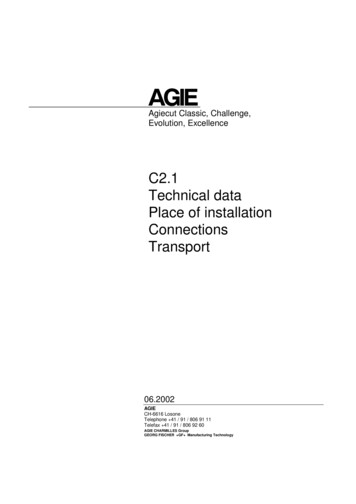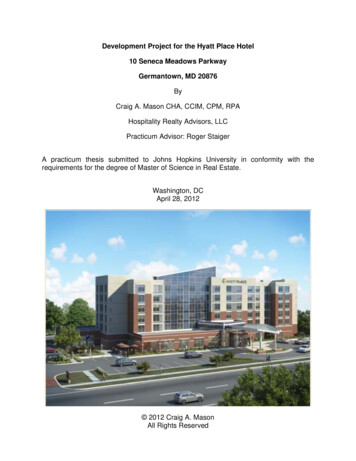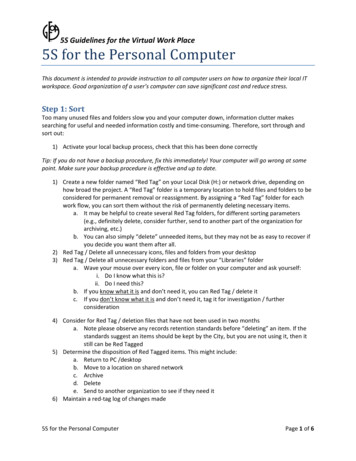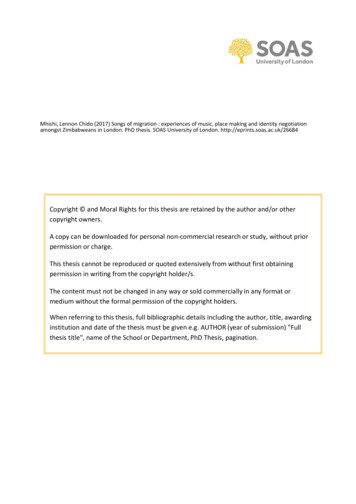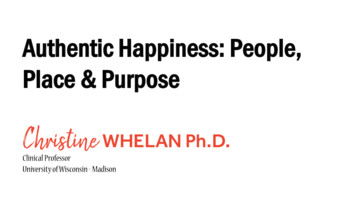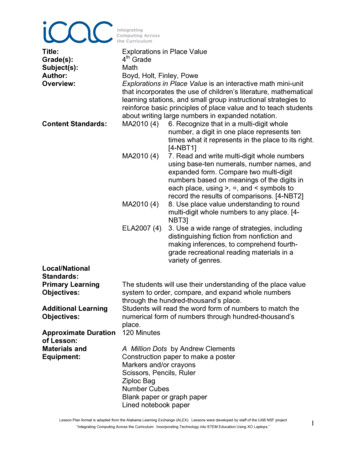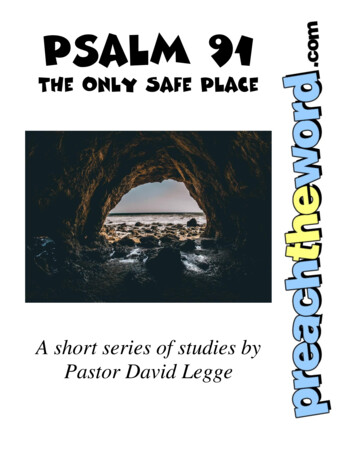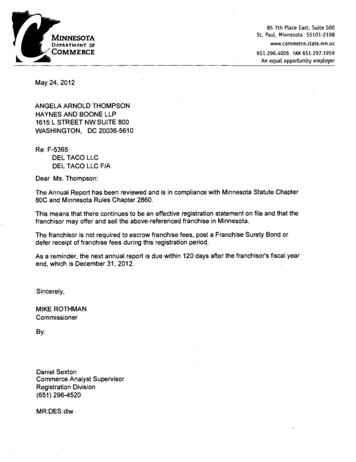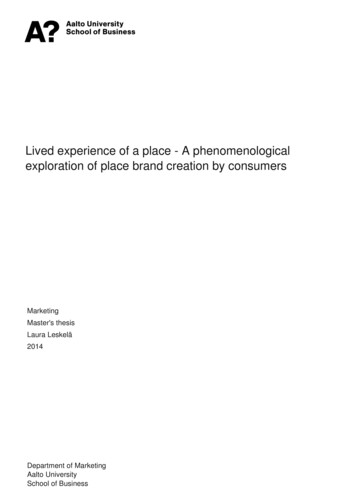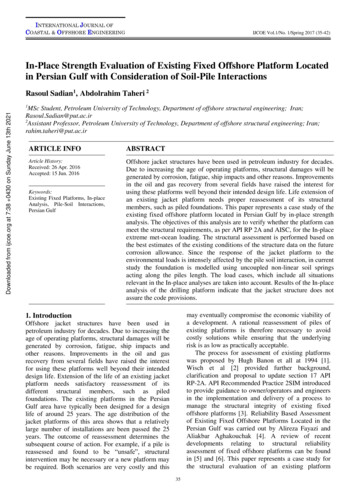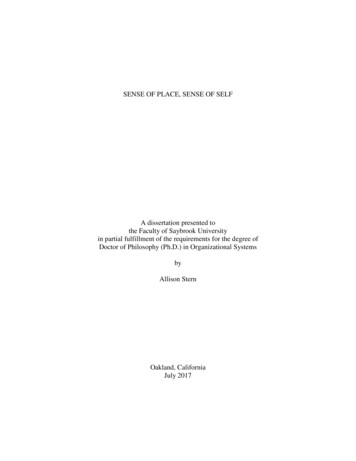
Transcription
SENSE OF PLACE, SENSE OF SELFA dissertation presented tothe Faculty of Saybrook Universityin partial fulfillment of the requirements for the degree ofDoctor of Philosophy (Ph.D.) in Organizational SystemsbyAllison SternOakland, CaliforniaJuly 2017
2017 by Allison Stern
Approval of the DissertationSENSE OF PLACE, SENSE OF SELFThis dissertation by Allison Stern has been approved by the committee members below, whorecommend it be accepted by the faculty of Saybrook University in partial fulfillment of therequirements for the degree ofDoctor of Philosophy in Organizational SystemsDissertation Committee:Kathia Laszlo, Ph.D., ChairDateGary Metcalf, Ph.D.DateAlan Briskin, Ph.D.Date
iiAbstractSENSE OF PLACE, SENSE OF SELFAllison SternSaybrook UniversityThe purpose of this dissertation was to investigate how powerful experiences of placeshape one’s sense of self. The human–place relationship is germane to today’s rapidly changingglobal landscape of political instability, conflict, climate change, population growth, and lack ofopportunity, all of which are increasing human displacement, migration, and mobility. Furtherexploration of place identity is thus relevant to addressing these issues. This interdisciplinarystudy examined the literature in sense of place, sense of self, place identity, and transformativeexperiences. The research question was: How do powerful experiences of place form, inform,and transform one’s sense of self?This qualitative study used Finlay and Evans’s (2009) phenomenological RelationalApproach. The data sources were in-depth interviews with 8 participants, selected throughpurposive and snowball sampling. Interview were conducted in 2 parts. The first part uncoveredparticipants’ essential descriptions and meanings of powerfully transformative experiences ofplace. 6 themes emerged: (a) natural elements and geography, (b) community, roots, andbelonging, (c) aliveness, wholeness, and the cycle of life, (d) freedom, adventure, and escape, (e)
iiipossibility, becoming, liminality, and the unknown, and (f) enchantment, the sacred, andcoherence. Data from the second part were categorized by how experiences formed, informed, ortransformed participants’ sense of self and life path. 5 dimensions of experiences were alsonoted: peak, plateau, nadir, epiphany, and liminal states. Further analysis revealed 4 largerpatterns. The first pattern was an opposing tension of forces between participants’ sense of selfcontinuity and change, based on 3 meta themes of The Known, The Unknown, and TheBalancing Present. The second pattern related to participants’ seeking similar place experiences.The third pattern noted variations in dimensions of experiences across the lifespan. The fourthpattern pointed to participants’ felt-sense of coherence and spirituality.This study contributes to a greater understanding of how powerful experiences of placeform, inform, and transform individuals’ relationships with themselves, others, and the largerworld. Implications indicate a need for the cultivation of greater awareness of the people–placerelationship toward a more coherent partnership. Further research into co-affecting factorsinfluencing place identity formation and development is needed.
ivAcknowledgmentsThis dissertation was fueled by an inspiring legacy of previous research, enthusiastic studyparticipants, and support and encouragement from faculty, colleagues, friends, and family.I am grateful to:My generous participants, who shared their powerful experiences of place and in so doing,reminded me that my topic is vitally important and personally meaningful. Thank you each foryour interest, wisdom, and scholarship.My committee members, Drs. Kathia Laszlo, Gary Metcalf, and Alan Briskin. Each provided aunique perspective that contributed to improving my thinking and this dissertation. Thank you toDr. Kathia Laszlo for being an inspiration since the very start of this journey, and forencouraging me to follow my own path. To Dr. Gary Metcalf, thank you for your reliability,availability, and your clarity of thought, especially toward the end, when I really neededfeedback. To Dr. Alan Briskin, thank you for your passionate appreciation of the power of sacredplaces and spaces. Thank you also for challenging me and supporting me at several criticaljunctures in this process, enabling my deeper thinking and scholarship.My friend and editor, Monika Landenhamer, who from my first library research class to this finalediting, has been a critically supportive cheerleader. Thank you Monika for your patience, keenlistening, and perfectionistic tendencies.My Wednesday Group, Jim Best, Natasha Mantler, Dolores Opon, and Eric Reynolds, for yourongoing support and our collaborative “Keep Going” spirit, and my Tuesday Group, Jim Bestand Lisa Fisher, for your deep listening and affirming friendship.My friend, Jo Sundet, for your authenticity, cleverness, and big heart, which have kept me going,in good times and bad, through our learning adventures. My friend, Debra Rosenbaum, for yourlifelong friendship and our shared passions of design, architecture, place, and space. My friend,Santina Hovanessian, for inviting me to co-create and continue learning, together. My friend,Lynn Harrison, for paving the way, modeling active listening, kindness, and grit.My friends and colleagues, old and new, for their friendship, support, and sisterhood, including:Katherine Melchior Ray, Maria Cristini, Lisa Clark, Catherine Edelmann, Joyce Goodwin,Allison Post, Sina Hanson, Susie Kabeiseman, Victoria Rubenstein-Schwartz, ShekinahShephard, Deena Kolbert, Noffi Yelloz, Konstantina Katsanou, and Kim Brice.My parents, Carol and Earl Stern, for their encouragement and long-term commitment to eachother and my education.My husband and life-journeyer, Greg Lindae, whose sense of humor, irreverence, commitment,and encouragement have accompanied me all along. He and the mighty Duke have been mysteady and patient reminders that I could, and would, complete this work.
vTable of ContentsList of Tables . xiList of Figures . xiiCHAPTER 1: INTRODUCTION . 1Purpose. 1Background . 1Place Identity in Context. 2Research Question . 7Researcher’s Relationship to the Topic . 8Definitions of Key Terminology. 9Organization of the Dissertation . 13CHAPTER 2: REVIEW OF THE LITERATURE . 16Introduction . 16Place . 17Facets of Place . 19Sense of Place and Placelessness . 21Place Attachment . 25Phenomenology of Place. 29Summary . 35Sense of Self . 36Concept and Definition of Self . 36Self-Concept . 41Identity Theories . 43
viSocial Identity Theory. 45Identity Theory. 46Identity Process Theory . 48Place Identity . 51Summary . 58Powerful Experiences . 59Powerful Transformative Experiences: Definitions. 59Perspectives of Transformative Experiences . 61Wisdom Traditions and Timeless Ways of Knowing . 61Rites of Passage Framework . 63Archetypal and Mythical Journeys . 64Contemporary Approaches to Transformation . 65Transformative Learning Theory . 67Adult-Constructive Development Theory. 69Theory-U . 71Types and Dimensions of Transformative Experiences . 72Nadir Experiences . 74Liminality. 75Peak Experiences . 77Plateau Experiences . 79Epiphanies . 80Summary . 80CHAPTER 3: RESEARCH METHOD . 82
viiIntroduction . 82Research Question . 82Choice and Rationale for Methodology . 83Research Design. 89Open Presence . 89Embodied Inter-Subjectivity . 90Dialogic Co-Creation . 91Entangled Selves . 92Research Setting. 92Participants . 93Participant Selection Criteria . 94Participant Selection Method . 95Ethical Considerations . 95Data Collection . 96Procedures .
concept and experience of what is specifically referred to as place identity remains less explored among scholars. A basic definition of place identity refers to a cross-disciplinary cluster of ideas related to place and identity concerning the significance and meaning of places for their
